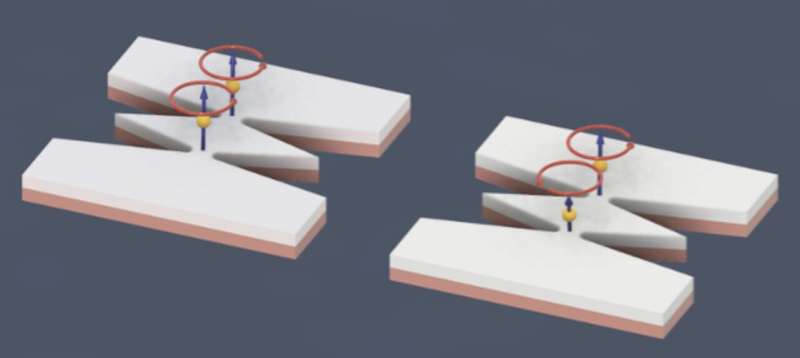Spin Hall nano-oscillators (SHNOs) are nanoscale spintronic devices that convert direct current into high-frequency microwave signals through spin wave auto-oscillations. This is a type of nonlinear magnetization oscillations that are self-sustained without the need for a periodic external force.
Theoretical and simulation studies found that propagating spin-wave modes, in which spin waves move across materials instead of being confined to the auto-oscillation region, can promote the coupling between SHNOs.
This coupling may in turn be harnessed to adjust the timing of oscillations in these devices, which could be advantageous for the development of neuromorphic computing systems and other spintronic devices.
Researchers at the University of Gothenburg in Sweden and Tohoku University in Japan, in a paper published in Nature Physics, have experimentally demonstrated such spin-wave mediated SHNO-to-SHNO coupling. Their study also shows how to achieve voltage control the timing and the phase of the coupling between the SHNOs.
“For the past two decades, our group (the Applied Spintronics Group at University of Gothenburg led by Prof. Johan Åkerman) has been working on spintronic oscillators, their mutual synchronization, and applications in fields such as telecommunications, neuromorphic computing, and, most recently, Ising machines,” Akash Kumar, first author of the paper, told Phys.org.
“The present study was inspired by the discovery of propagating spin waves in spin Hall nano-oscillators (SHNOs).”
As part of earlier research, the team at the University of Gothenburg was able to realize propagating spin waves in SHNOs for the first time, using optimized thin-film samples of the material W/CoFeB/MgO.
This crucial achievement laid the foundation for their current study, which was aimed at dynamically controlling the mutual synchronization of SHNOs using the physics of spin waves, specifically by transferring phase information between the oscillators.
“Such control is essential for achieving long-range, one-to-one coupling between separated SHNO pairs, as well as in longer chains,” said Kumar. “This breaks the barrier of nearest-neighbor-limited coupling seen in previously demonstrated systems.”
To carry out their experiments, Kumar and his colleagues used devices with two SHNO that are easy to fabricate. Building on their previous studies, they were able to demonstrate a mutual synchronization between these devices, which was mediated by propagating spin waves.

“SHNOs are versatile oscillators that exhibit large frequency nonlinearity, can be fabricated at sizes as small as 10 nm and are capable of mutual synchronization in large one-dimensional chains and two-dimensional arrays,” explained Kumar. “The spin waves in these devices enable the transmission of phase and amplitude information from one SHNO to another, which was absent in previous demonstrations.”
The researchers created the SHNO devices they used in their experiments employing common nano-fabrication processes. To attain the desired mutual synchronization between the two devices, they carefully tuned the magnetic anisotropy and separation between them.
“We first observed the signature of phase-tuned mutual synchronization in electrical measurements, where we measured the power spectral density using high-frequency spectrum analyzers,” said Kumar.
“To confirm our findings, we then performed phase-resolved Brillouin light scattering (μ-BLS) microscopy measurements using our state-of-the-art facility, which allowed us to directly visualize the phase of each oscillator and validate our hypothesis,” said Avinash Kumar Chaurasiya, a shared first-author of the study, and responsible for the microscopy measurements.
“To further validate their results and confirm the presence of phase-tuned mutual synchronization between the oscillators, I ran a series of micromagnetic simulations,” said graduate student Victor González, also shared first-author of the paper. These simulations confirmed the original hypothesis, highlighting the potential of their approach for controlling the coupling between SHNO devices.
“The transfer of phase information between SHNOs will be highly useful for a number of applications,” said Kumar.
“With further scaling and voltage control, this coupling can enable SHNO devices to be utilized for Ising machines, which are combinatorial optimization hardware-based calculation accelerators. These machines have the potential to operate at room temperature and are truly nanoscopic in size, making them both practical and highly efficient.”
This recent study by Kumar and his colleagues highlights the possibility of leveraging propagating spin waves to dynamically control the coupling between SHNOs. In the future, it could open new exciting possibilities for the development of various spintronic devices that could be better equipped to tackle real-world optimization and computational tasks.
“As part of our next studies, we plan to scale the system to incorporate a large number of SHNOs and using voltage gating to provide energy-efficient, on-demand local control of coupling,” added Kumar. “These advancements will make these devices truly functional for real-world applications.”
More information:
Akash Kumar et al, Spin-wave-mediated mutual synchronization and phase tuning in spin Hall nano-oscillators, Nature Physics (2025). DOI: 10.1038/s41567-024-02728-1.
© 2025 Science X Network
Citation:
Study demonstrates phase-tunable spin-wave-mediated mutual synchronization of spin Hall nano-oscillators (2025, February 1)
retrieved 1 February 2025
from https://phys.org/news/2025-01-phase-tunable-mutual-synchronization-hall.html
This document is subject to copyright. Apart from any fair dealing for the purpose of private study or research, no
part may be reproduced without the written permission. The content is provided for information purposes only.

